









MotoRater
Features
- Fine kinematic gait analysis in 4 modalities: walking, ladder walking, wading, swimming
- Observation and analysis of 3 animal sides (ventral, lateral right/left)
- Data from all relevant body parts – not just paws
- Movement analysis based on trajectories of joint positions and angles with respective properties (i.e. velocity and acceleration)
- More than 100 parameters
- High sensitivity: MotoRater allows to detect subtle to severe gait changes in various animal models
- Combines with several other methods (e.g. Electrophysiology, Optogenetics and Telemetry)
Application
- Fine Motor Kinematic Analysis
Disease models
- Stroke
- Huntington’s
- Multiple sclerosis
- Amyotrophic lateral sclerosis
- Duchenne muscular dystrophy
- Parkinson’s
- Batten disease
- Other neurological and rare diseases
MotoRater is a semi-automated system for rodent kinematic gait analysis with high sensitivity to evaluate 4 different motion modalities – overground walking, skilled ladder walking, wading in water and swimming. In contrast to conventional methods, MotoRater allows testing animals in the water, which offers the exceptional opportunity to evaluate severely impaired rodent models, which would not be able to support their body weight on solid ground.
MotoRater observes the animal from 3 sides simultaneously (ventral, left, right) and provides detailed readouts of all body parts relevant to the motion, i.e. paws, ankles, joints, tail, head, hip, iliac crest, etc. – allowing reliable detection of subtle deviations, early symptom onset and treatment effects. MotoRater combines/synchronizes with external devices (EEG, EMG) and allows the implementation of other methods (e.g. Optogenetics Bouvier et al 2015, electro-myographic recordings Zörner et al 2010).
MotoRater, therefore, allows the objective phenotyping of various disease models with traits of impaired locomotor ability and detects subtle effects after genetic or pharmacological intervention. Fine motor kinematic gait analyses conducted with MotoRater (with more than 100 kinematic gait parameters) is a very sensitive way to measure motor skills with high translational value. Kinematic gait analysis in humans is done by a number of digital motion-capture cameras that record the position of light reflective markers attached to the patient’s joints. Hence, fine motor kinematic gait analyses conducted with MotoRater is the most accurate method to compare rodent gait with human conditions.
The following kinematic gait parameters can be analyzed through Motorater (over 100 parameters in total):
- General spatio-temporal patterns - Stride distance, duration, speed, stance time, swing time
- Inter-limb coordination - Diagonal cadence, left/right alternation rhythm
- Swing phase and paw trajectory - Swing speed, smoothness, trajectory shape, abnormality
- Body posture and joint angles - Hip height, tail & nose height, limb function
- Gait variability, deviations - Retraction, protraction
Yoshizaki S, Kijima K, Hara M, Saito T, Tamaru T, Tanaka M, Konno D-J, Nakashima, Okada S. Tranexamic acid reduces heme cytotoxicity via the TLR4/TNF axis and ameliorates functional recovery after spinal cord injury. J Neuroinflammation. 2019; 16: 1–15.
Krupa P, Svobodova B, Dubisova J, Kubinova S, Jendelova P, Machova Urdzikova L. Nano-formulated curcumin (LipodisqTM) modulates the local inflammatory response, reduces glial scar and preserves the white matter after spinal cord injury in rats. Neuropharmacology. 2019; 155: 54–64.
Chen B, Li Y, Yu B, Zhang Z, Brommer B, Williams PR, Liu Y, Hegarty SV, Zhou S, Zhu J, Guo H, Lu Y, Zhang Y, Gu X, He Z. Reactivation of Dormant Relay Pathways in Injured Spinal Cord by KCC2 Manipulations. Cell. 2018; 174: 521-535.
Preisig DF, Kulic L, Krüger M, Wirth F, McAfoose J, Späni C, Gantenbein P, Derungs R, Nitsch RM, Welt T. High-speed video gait analysis reveals early and characteristic locomotor phenotypes in mouse models of neurodegenerative movement disorders. Behav Brain Res. 2016; 311: 340–353.
Zörner B, Filli L, Starkey ML, Gonzenbach R, Kasper H, Röthlisberger M, Bolliger M, Schwab ME. Profiling locomotor recovery: Comprehensive quantification of impairments after CNS damage in rodents. Nat Methods. 2010; 7 (9): 701-708.










